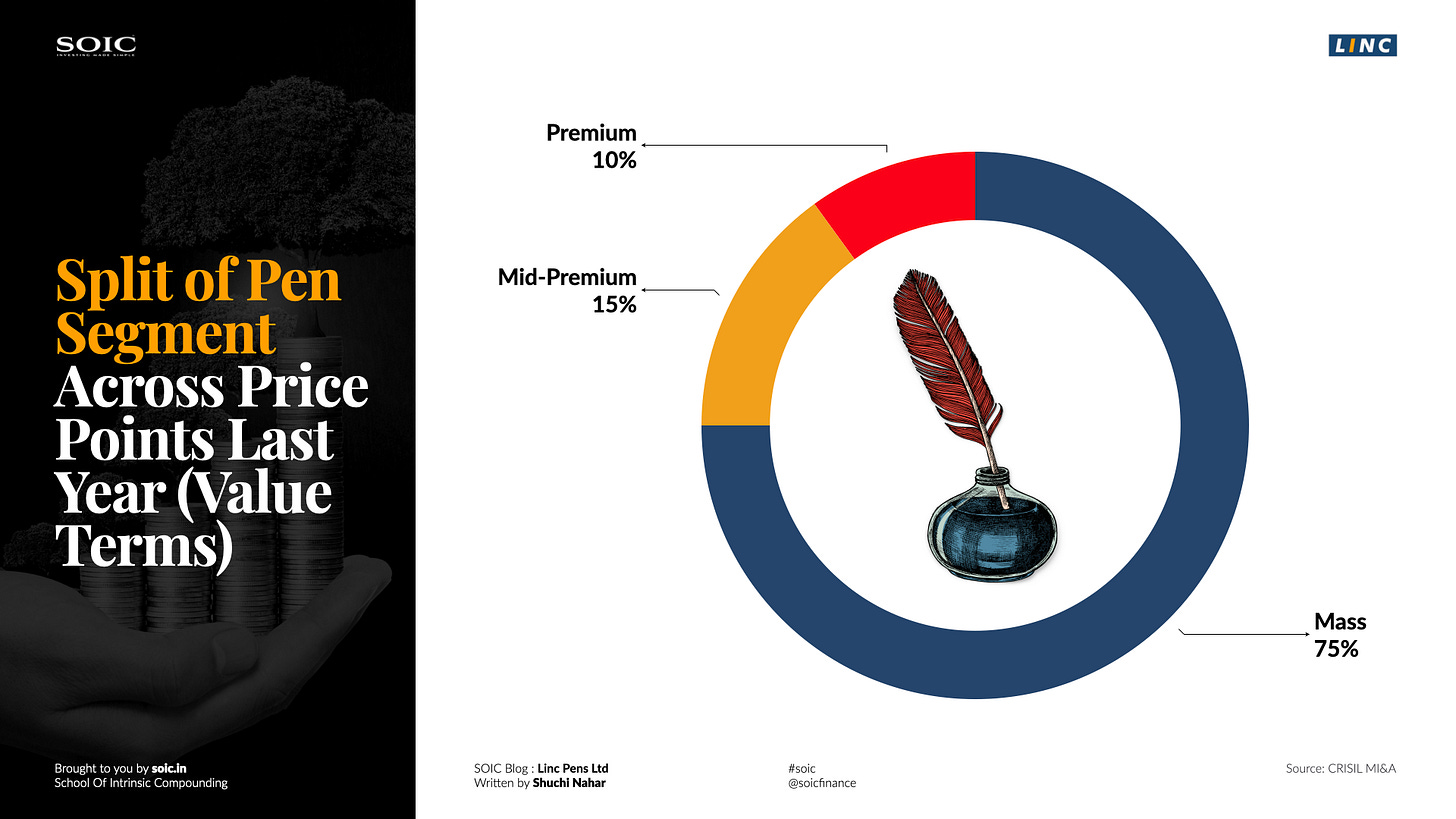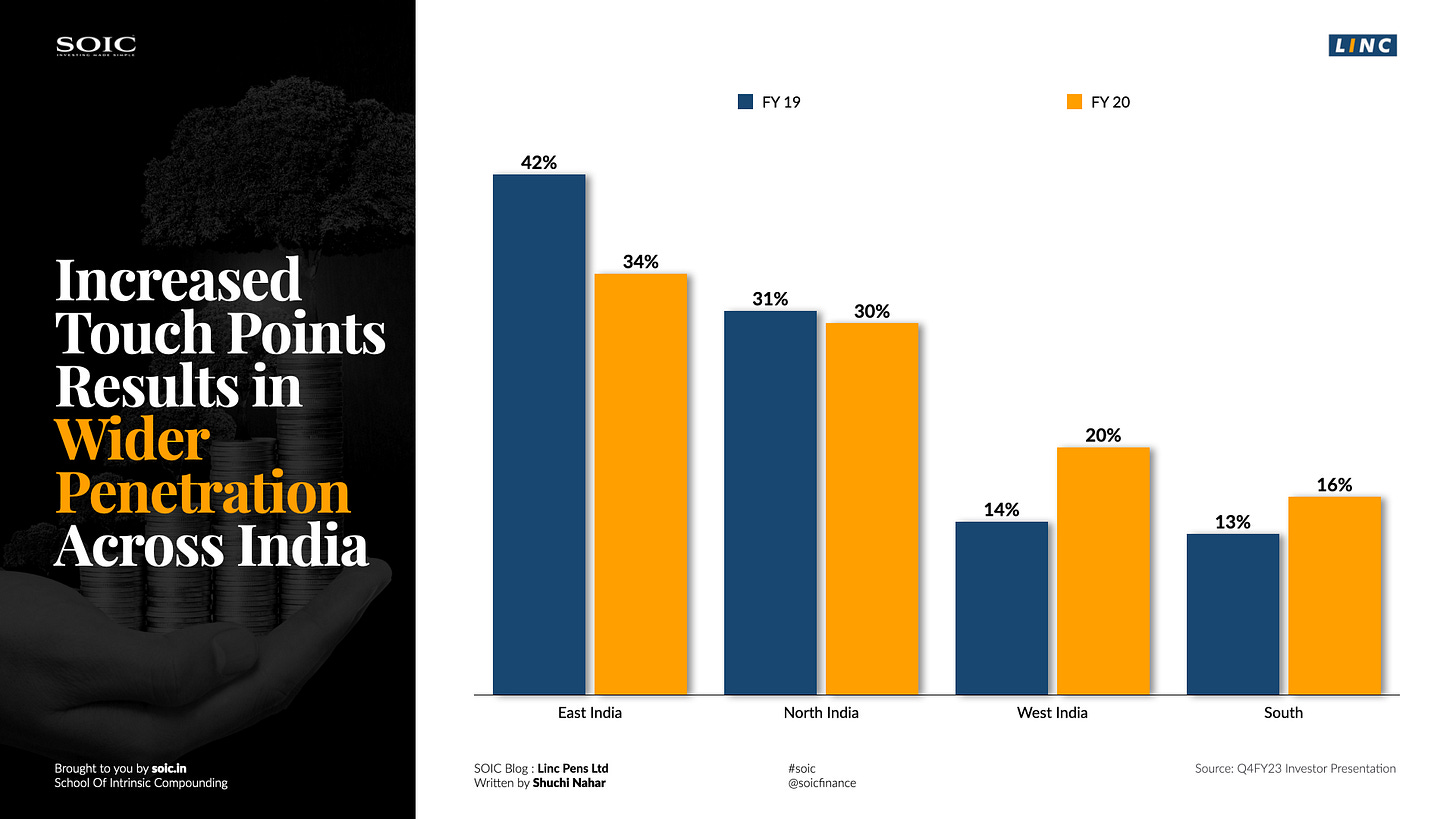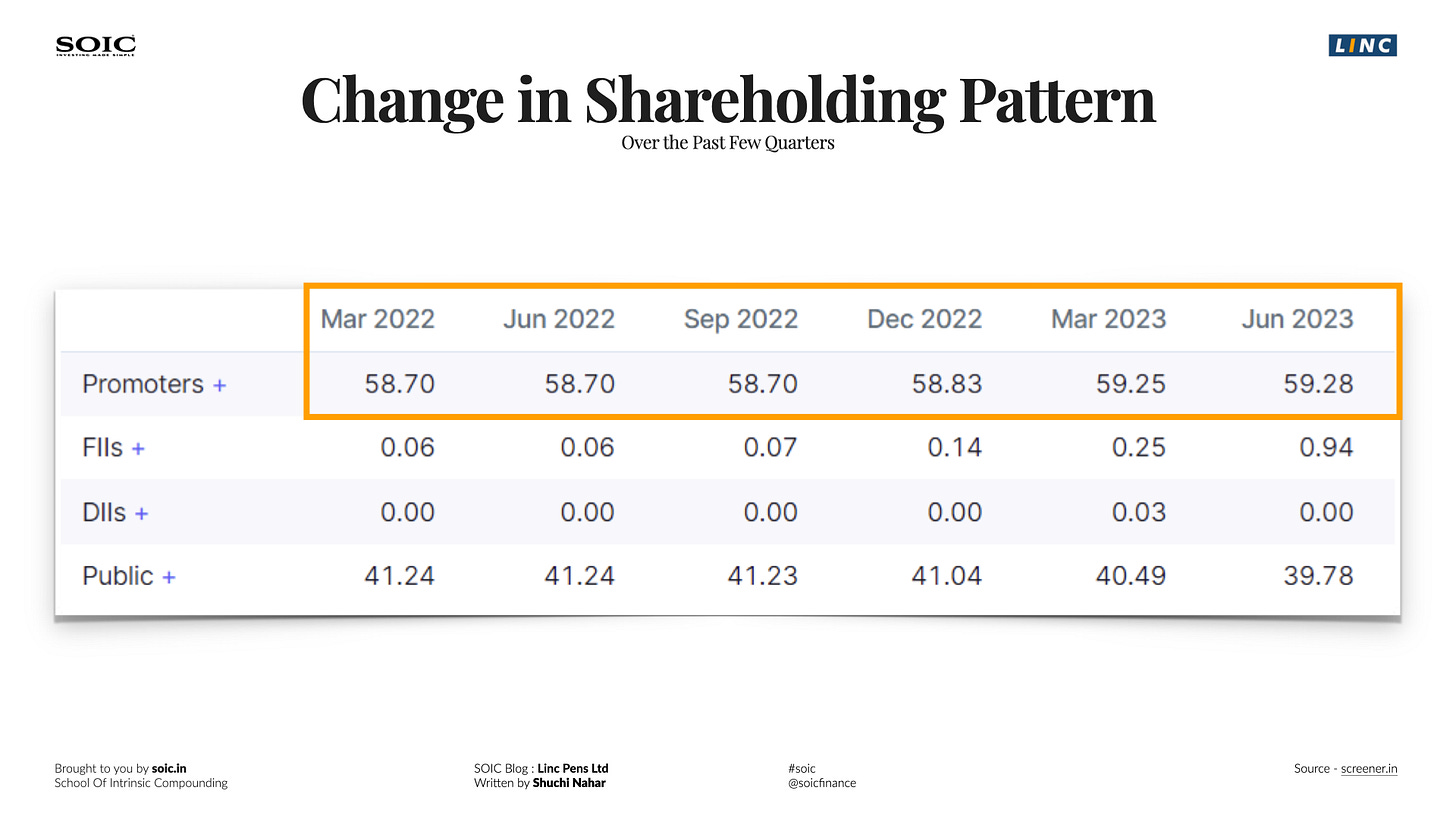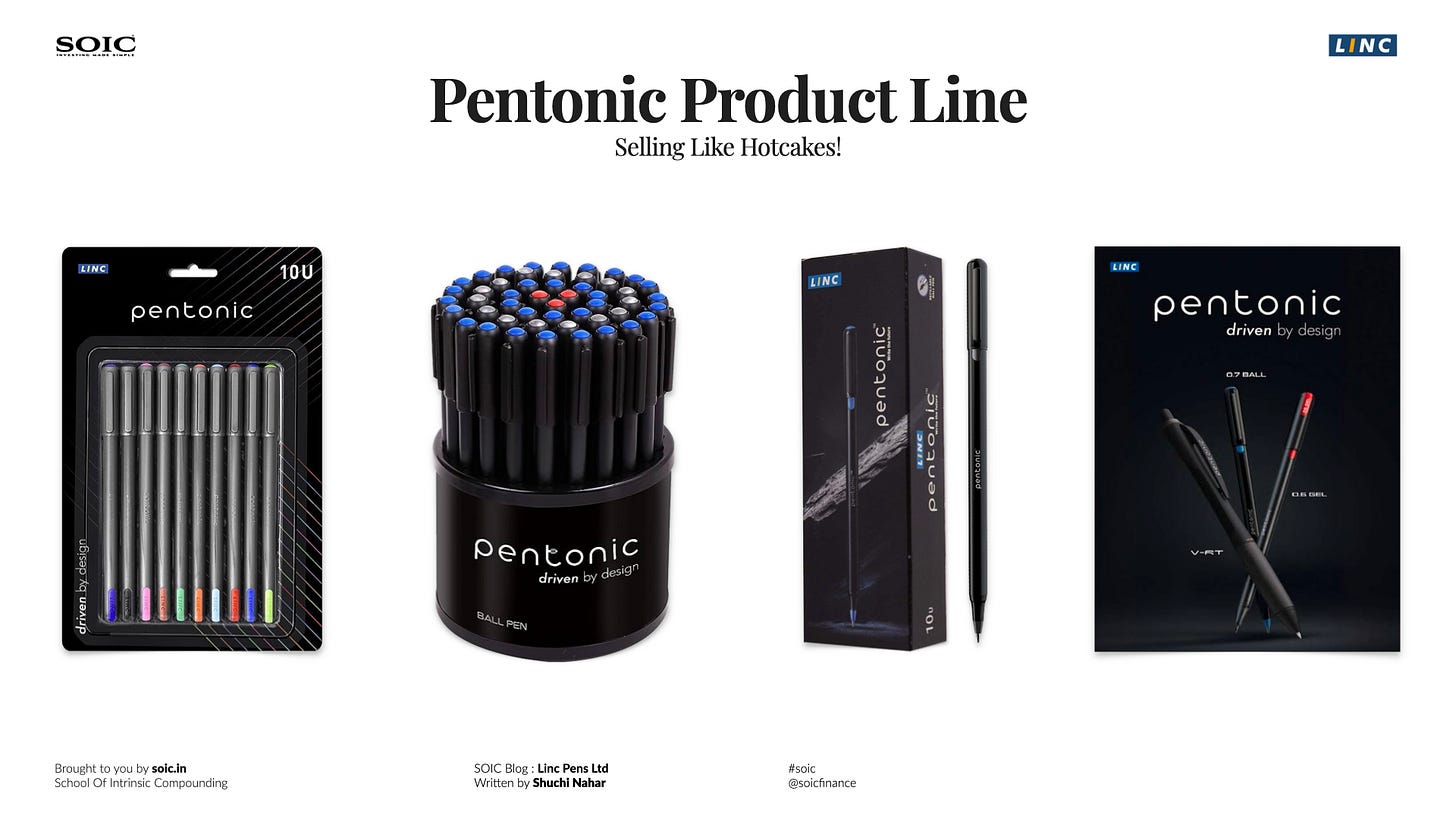Linc's Pentonic Pens - Is This A Game Changer In The Market?
10 mins readPublishing Date : 2023-08-14
Industry Overview
The organized writing instrument market in India is booming and is thought to be worth about Rs 3,450 crore. The industry has a sizable unorganized sector that makes up 25% of the market and seven significant organized players.
The pen category can also be broken down into three price ranges based on sticker prices: up to Rs 5, Rs 10–20, and Rs 25 and up (semi-premium and premium). Approximately 80% of the Indian pen industry's profits come from pens that cost less than Rs 15 each, and a small portion comes from pens that cost between Rs 100 and Rs 300. The market for pens below Rs 15 is expanding at a rate of 7-8% per year, while the market for pens above Rs 15 is expanding at a rate of about 8-10% per year. Around 60% of writing instrument consumers are students.
The largest population in the age bracket of 5-24 years is 580 million.
The Indian working population is expected to grow by 20%, and the education market is expected to grow by ~ 14%. Writing instrument growth prospects are very strong.
Over 250 million school-going students and over 38 million students are enrolled in higher education.
Rising literacy rate
A government initiative such as Sarva Shiksha has strengthened India's literacy from 65% in 2001 to 77.70% in 2021. The objective of attaining 100% literacy levels by 2025 could have a positive impact on the writing instrument sector.
Educational Spending - Budget estimates for 2023-24 show that the government will spend ₹ 1.12 lakh crore in the coming fiscal year on education – the highest ever and an increase of around 8.2% compared to what was pegged in 2022-23.
Global Writing & Marking Instruments Market Size
The USA's GDP is estimated at US$4.7 Billion in 2022.
80% of revenue from pens is below ₹ 15 per piece
Market for Pen below ₹ 15 growing at ~8%
The market for Pen above ₹ 15 growing at ~ 10%
55% of consumers are students; 20% are office workers.
Linc, Cello, Flair, and Reynolds are the major players in the Indian pen market in the mass segment category, where the price of the writing instruments is below Rs. 20
India’s Writing Instruments Market Growth Drivers
Rising Populations
China is forecasted to reach a projected market size of US$8.7 Billion by the year 2030, at a CAGR of 14.7% by 2030
Japan and Canada, are each forecasted to grow at 4.6% and 7.7%, respectively, over the 2022- 2030 period, while Germany is forecasted to grow at ~ 5.6% CAGR.
Growth Drivers
Rise in education in 3rd world countries.
Rising trend of corporate gifting.
Demand for Luxury Instruments.
Corporate gifting market at $120 bn
Coloring instrument demand growing faster, due to a surge in demand for highlighters, markers, etc.
Pens continue to be the largest share at ~ 60%
In the mass segment, where the price of the writing instruments is below Rs20, the large players comprise Linc, Cello, and Rorito. In the high-value segment, where the price is between Rs 20 and Rs 400, the prominent market players are Uniball, Pilot, and Parker. In the premium segment, where the price is above 400, the major market players are Mont Blanc, Parker, Cross, Lamy, and Sheaffer.
Global Stationery Industry Opportunity
Growth Drivers
Rising inclination toward higher education
Demand from the corporate sector
Increase in customized and personalized stationery
Increased Literacy rate in the developing world
Market Segment
US Market is estimated at $52 Bn
China Market at $33 Bn, to grow faster @ 3.6% CAGR
Japan will grow at 0.2% only, while Canada will grow at 1.3%
The education sector held the largest share of the market at 45.3%
The stationery industry is divided into paper and non-paper stationery, with the latter accounting for the larger share.
Company History
Linc Limited is a company in the pen and stationery space. The company had been in the lower-end pen business for a long time and was selling lower-priced pens. As a result, the company had 7-10% operating margins from 2011 to 2020. The company was impacted by GST in the 2017-19 period and a slowdown in exports.
The increase in polymer prices had a further impact on operating margins. The company introduced the Pentonic brand in 2018, which has been successful.
Turnaround
2019 did not see much progress, but 2020 saw topline growth of 10%, and OPM increased to 10%, driven by the success of the new brand. However, COVID meant that retail sales dropped, and 2021 was a washout. Performance has recovered from 2022 and the main driver was the Pentonic brand which achieved 50 Crs in the last two years.
Linc 2.0: Rewriting the Growth Story Linc has decisively undergone a paradigm shift in its business model. The company has unleashed Linc 2.0: a five-pronged strategy to drive the next leg of growth.
1) Increase touchpoints
2) Emphasis on higher-margin products
3) Widening the stationery portfolio
4) Enhancing existing capacity
5) Improve on the ESG aspect The fundamental goal is to expand the "Range" and widen the "Reach" of its products.
Current Scenario
Linc Ltd. (Linc) is a well-known domestic manufacturer of writing instruments with strong brand recognition and a solid reputation in the industry. Since introducing the first ballpoint pen in India in the 1980s for Rs. 2, Linc has developed a number of ground-breaking products. Most recently, it introduced the "Hi-School" gel pen for Rs. 10 per unit (the going rate for gel pens was Rs. 15–20 per unit).
Linc introduced the Smart oil-based gel pen in 2002 for Rs 5. The most popular gel pen is the Linc Ocean Gel Pen, which was introduced in 2003. Linc Signetta and Link Twinn are two additional significant launches. However, the Pentatonic, which debuted in FY19, has so far been the company's most significant launch.
Pentonic: The "tonic" for growth and a game-changer. The organized writing instrument market, which is worth Rs 3,000 crore out of the Rs 4,500 crore total market, is dominated by names like Cello, Reynolds, Flair, and Linc Pen.
The majority of their products, which are all mass-market, range in price from $5 to $20. Since there is little to no brand differentiation and unorganized players sell their pens for as little as Rs. 2–3, the majority of organized brands have been unable to raise prices in nearly a decade.
The company's growth trajectory has been reshaped as a result of its success in FY23, which surprised the sector. Additionally, the business is the sole provider of Mitsubishi Pencil Company (Japan)'s Uni-Ball brand pens. Mitsubishi Pencil Company (Japan) also owns a 13.5% stake in Linc. Additionally, Linc partnered with Deli (the biggest stationery manufacturer in Asia) in 2018 to distribute its products exclusively in India, allowing it to expand beyond writing instruments.
The demand for educational products is anticipated to remain strong as efforts to raise literacy levels domestically gain momentum. With its expanding "Reach" and "Range" along with better brand salience, Linc is well positioned to expand.
Financial Snapshot
On the back of its renewed commitment to growth, it's expected that the company will report Revenue and PAT growth of 24% and 90% (partly due to a low base) over FY22-25E. Lower working capital requirements and improved profitability have improved the company’s cash generation while also bolstering its return profile. Linc aims to maintain a healthy, deleveraged balance sheet in the future by financing its operations largely through cash accruals.
Linc's revenue stagnated at Rs. 350 crore between 2015-2019. Then the company launched its Pentonic line of pens. The key USP of Pentonic is its unique design along with writing smoothness at an affordable price of Rs. 10. Pentonic has been a runaway success, as in just over three years, Pentonic now contributes over 30% of the company’s revenue as against only 7% in FY19.
Due to a higher Gross Margin of over 40% for Pentonic, the company’s average Gross margin, which was below 35% in FY18, has steadily increased to more than 40% in Q3 FY23. Currently, the Pentonic portfolio consists of three key products, Rs. 10 ball pen (the first product launched under the Pentonic brand in FY19), a Rs. 10 gel pen, and a Rs. 20 ball pen. It is on the verge of launching a Rs. 40 pen, the test launch for which has already been undertaken in Kolkata.
Likewise, the company plans to launch a series of products across price points (Rs. 10 plus) at regular intervals as it seeks to move up the premiumization ladder. We believe that the success of Pentonic could translate into the success of a family of products, including non-writing instruments, to be launched in the foreseeable future.
Strategy
The company introduced the Pentonic brand in 2018, which is a 10 Rs brand, and, per management, is expected to be the driver of long-term success. Linc Ltd.'s management has laid out a series of plans to add shareholder value, including expanding the distribution network, increasing advertising and promotional spending, and focusing on retail pull versus distributor push.
CAPEX
Linc plans to increase its existing capacity in Gujarat from 10 lacs pen per day to 15 lacs per pen per day in FY’25 & to 20 lacs pen per day subsequently.
FY’24 demand would be met by the existing capacity and stepped-up outsourcing, which has already been tied up
The revenue potential of the new facility at full capacity will be ~ ₹15,000 lacs
Total Project cost ~ ₹5,000 lacs. Infrastructure costs of ~₹1,700 lacs will be spent in FY’24 through internal accruals
Phase 1 Plant & Machinery of ~₹,1,800 Lacs in FY25, & Phase 2 ~₹1,500 Lacs subsequently.
The new plant is at the existing location (Umbergaon) to rationalize logistics and economic synergies.
Capacity expansion is being phased to align with demand and the company’s capital allocation strategy
Management guidelines for CAPEX and Outsourcing
So like in the peak season, they are actually short of capacities, and so for their forecast of FY25, they would need an additional capacity of at least 30 crores. In addition, they will need 30 Crores of pen capacity, of which they plan to outsource about 50%, and the remaining 50% we would like to produce in-house by increasing our capacity.
Expanding reach
The company started focusing on distribution in West and South India, where it is weak - Expand distribution from Stationery stores to Kirana, Medical, Pan, and other general outlets (from 0 to 1,40,000 outlets and total outlets increased by 175K)
The plan is to increase from 65,000 outlets to 5,00,000 outlets.
Increased focus and growth from the e-commerce channel
Focus on retail pull versus distributor push (selling through 100+ telecallers who work with retailers)
Started expanding aggregately to neighborhood grocery stores (Kirana, Medical stores, Pan stores, etc.) since FY20 to increase footprint.
Added over 1,80,543 touch points since FY’20; 14,969 over the last 1 year
Spent over ₹ 4,100 lacs on brands over last 5 years
Step up brand spending going forward ~ 3% of revenue
Increased touch points result in Wider Penetration across India
Brand building
- Brand building (now spending 2% on advertising and promotion and will take this to 3%)
- The Pentonic brand accounts for 30% of total sales.
- Plans to add more products in the Pentonic brand range.
Improving sales and margin
- GPM improved from 22% in FY18 to 31.3% in FY23 (due to a 40% margin in the Pentonic range). This is allowing the company to spend on brand building. The company aims to maintain existing margins or have a slight uptick in margins in the next two years.
- The company is revising its guidance upward to achieve a top line of over Rs. 750 crore by FY25 with a CAGR of around 25%.
- The company has a mix of their own capacity and outsourcing, with the ratio being 50:50, and they plan to maintain this ratio going forward.
Focus on higher-margin products
The pentonic range of pens yields >40% gross margins compared to <25% for lower-priced products.
The increasing contribution from Pentonic has improved the company’s realizations and profit margins. Going forward, the new launches will be at higher price points. Linc believes this offers a great learning opportunity for the company without any significant cost. Depending on the response to its products, the company may engage in manufacturing such products in-house in the future.
The Pentonic brand was introduced in FY19 as a minimalistic yet contemporary pen, known for its aesthetics as well as writing smoothness.
Positioned at ₹ 10 + segment, Pentonic’s GPM is ~ 42%. Increase in the share of Pentonic in total revenue, leading to a higher GPM at the company level. Pentonic pen volume increased by over 53%.
Expanding portfolio – Foraying into Stationery products
The company is expanding beyond pens to other stationery items like highlighters by building on its relationships with Uniball and Deli. Plan to Hit 100 million with Deli by FY26 by leveraging the same sales and distribution network. Doubling capacity at the Umbergaon plant by investing 50 crore
The company started its foray into a full range of stationery products through its exclusive tie-up with Deli (Asia’s largest stationery manufacturer). Stationery products are highly complementary to the company’s existing portfolio, as Linc can leverage its robust distribution network to drive sales.
Deli has 1000+ SKUs, and Linc is currently distributing calculators, scissors, desk organizers, and files/folders. It is expected that the Deli business will add about Rs. 100 crores to the company's turnover in 3 to 4 years' time from the current Rs. 19 crore (9MFY23). Additionally, the company has had a long-standing partnership (since 1992) with Mitsubishi Pencil Co. Ltd, Japan.
Through its ‘Uni-Ball’ brand, Linc has a presence across all categories of premium writing instruments, such as roller pens, gel pens, and ball pens. These relationships represent an asset-light commitment to outsourcing stationery products from these international brands while the company continues to deepen the manufacturing competitiveness of its writing instruments.
Targeting over ₹7,500 lacs topline by FY25.
Deli offers a range of over 200 products in India.
Company to largely focus on Calculators & Scissors.
Deli should contribute at least 10 % of the company’s revenue by FY25.
Deli’s GPM is around 20%
Deli has achieved a revenue of ₹2,497 Lacs in FY’23
Finally, ROC has touched 23%, and if the company can improve its gross and operating margins, this should improve further.
Change in shareholding pattern over the past few quarters
Source - Screener.in
Management’s top 3 priorities for FY24 and FY25
Peer-2-peer comparison
Segmental presence of key players in the Indian writing and creative instrument Industry
Distribution network of some players in the writing and creative instrument industry
*For Linc Ltd., dealers'/distributors' data is as of Financial Year 2022, while wholesalers'/retailers' data is as of Financial Year 2023.
Future Outlook
We should be able to achieve high top-line and bottom-line growth in the near future thanks to their focus on the core strengths and the established strategy, strong demand for the company's products, and significant opportunities in the export market.
The company has adopted the following strategies. Increased touch points is the first step. More than 10 million non-stationary businesses, including Kiranas, medical shops, Paan Stores, and others, are present in India. Additionally, the company reached nearly 1.4 lakh of these outlets directly in FY20, bringing its total number of touchpoints to over 2.4 lakh outlets.
The company has also been able to increase its market penetration throughout India, leading to an increase in the revenue share from the south and west zones from 27% in FY19 to 36% in FY23. The company anticipates increasing its total reach to over 5,00,000 touchpoints by FY25, as I also mentioned in my earlier calls. Focus on higher margin products.
Management views on foraying into different countries
Q1FY24 Conference Call Update – Dated: August 1, 2023,
Linc 1Q FY24 conference call summary:
- Q1 is usually a steep quarter due to summer vacations.
- Ranking of highest margin products.
1. Pentonic
2. Uniball
3. Legacy products
4. Deli products
- Will gradually put more emphasis on selling online. As of now, 3% of the revenue share is from e-commerce.
- Pentonic is expected to drive stronger topline growth in the upcoming quarters.
- Pentonic has grown to a 150cr brand since its 2019 launch.
- Growth was muted in the first quarter due to a focus on profitability, which led to an increase in the selling price of legacy products and lower sales.
- Lower gross margin in the first quarter due to some variable cost spread on a lower revenue base.
- A joint venture for the production of goods and their sale both inside and outside of India with the South Korean company Morris. Essentially, it is contract manufacturing. Morris has a few items that are patented. Product prices range from Rs 30 to Rs 50. An investment of roughly 3–4 crores per year until FY25.
– FY24 revenue guidance of 600–625 cr; 750 cr for FY25. 15% EBITDA margin
- The Pentonic Rs40 pen was trial-released in Bombay, Pune, Chennai, and Kerela; it will be available throughout India in two to three months.
Deli's revenue last year was 25 crore, and it aims to reach 75 crore by FY25. Uniball is expecting a 15% share.
- Exports: Southeast Asia, Africa, the Middle East, Russia, Brazil, and a small portion of North America are the export markets. awaiting a significant change in North America.
- Looking forward to the Flair IPO to provide investors with better peer comparison and additional industry insights
- Allow for a 6-7% price increase to trade if polymer prices rise sharply by maintaining the product's MRP.
- The volume contribution for Q1 for MRP 10 is above 60%.
- The acquisition of Kenya aims to get around the tariff barrier and expects 15 crore in sales by FY25.
Key Points of Concern
• Intense competition in the writing instrument industry may affect Linc Pens Ltd.'s market share and profitability.
• Fluctuations in raw material prices, such as polymers, can impact production costs and margins.
• Possible disruptions in export markets could affect the company's revenues and growth prospects.
• A slip in execution
To sum up at a glance!
The shopkeeper added that Pentonic is one of the fastest-selling products and is a customer favorite.
Selling like hotcakes are Pentonics Rs 10 pens.
Expanding product portfolio
Another range of products – Pentonic B-RT
Our view is In this ever-changing landscape of business and consumer preferences, companies must strategize wisely to secure a promising future. For companies in the writing instrument and stationery industries, the road to success lies in driving sustained growth. Through this article, we explore the key factors that will shape the future of this industry, empowering our readers with valuable insights.
Disclaimer: The information provided in this reference is for educational purposes only and should not be considered investment advice or a recommendation. As an educational organization, our objective is to provide general knowledge and understanding of investment concepts. We are SEBI-registered Research analysts. This blog is only meant for educational purposes, and nothing on it constitutes investment advice.
It is recommended that you conduct your own research and analysis before making any investment decisions. We believe that investment decisions should be based on personal conviction and not borrowed from external sources. Therefore, we do not assume any liability or responsibility for any investment decisions made based on the information provided in this reference.























